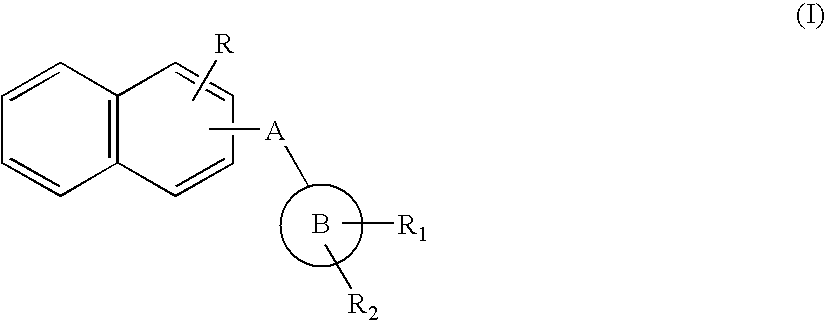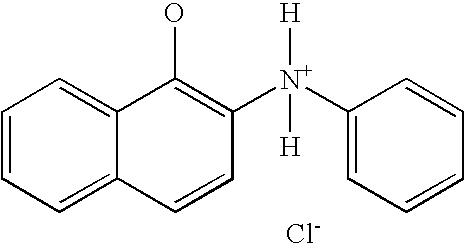Naphthyl Derivatives as Inhibitors of Beta-Amyloid Aggregation
a beta-amyloid and derivative technology, applied in the field of compounds, can solve the problems of inability to accurately distinguish between alzheimer's type degeneration and other degenerative phenomena, inability to specifically treat the amyloidogenic process, and interfere with the neurotransmitter mechanisms which govern learning and memory
- Summary
- Abstract
- Description
- Claims
- Application Information
AI Technical Summary
Problems solved by technology
Method used
Image
Examples
example 1
Preparation of Compounds of Formula (I) According to Synthetic
[0095]
Step i—Preparation of 4-methoxy-1-naphthalenamine
[0096]A suspension of 4-methoxy-1-nitronaphthalene (1.0 g, 4.9 mmol) in ethyl acetate (150 ml) was hydrogenated in Parr apparatus at room temperature in the presence of 10% Pd / C as a catalyst (200 mg) at an initial pressure of 60 psi for 4 h. The catalyst was removed by filtration and the filtrate was dried and evaporated to afford pure 4-metossi-1-naphthalenamine (850 mg, 100% yield), which was used for the next reaction without further purification.
Step ii—Preparation of 4-methylbenzoate-1-yl(4-methoxy-1-naphthyl)amine (ST3244)
[0097]A dried flask was purged with argon and charged with (±) BINAP (70 mg, 0.11 mmol) and capped with a rubber septum. The flask was purged with argon and toluene (9.7 ml) was added. The mixture was heated to 80° C. with stirring until the BINAP dissolved (˜1 min). The solution was cooled to room temperature, the septum was removed, and pall...
example 2
Preparation of Compounds of Formula (I) According to Synthetic Scheme 2
[0110]
Step i—Preparation of 1-methoxy-2-naphthalenamine
[0111]1-Methoxy-2-naphthalenamine was obtained with the same procedure reported for 4-methoxy-1-naphthalenamine using 1-methoxy-2-nitronaphthalene (3.70 g, 18.0 mmol) as starting material. The 1-methoxy-2-naphthylenamine (3.12 g, 100%) obtained was used for the next reaction without further purification.
Step ii—Preparation of (1-methoxy-2-naphthyl)phenylamine (ST2756)
[0112]A dried flask was purged with argon and charged with (±) BINAP (70 mg, 0.11 mmol) and capped with a rubber septum. The flask was purged with argon and toluene (9.7 ml) was added. The mixture was heated to 80° C. with stirring until the BINAP dissolved (˜1 min). The solution was cooled to room temperature, the septum was removed, and palladium acetate (16 mg, 0.07 mmol) was added. The flask was recapped with the septum and then purged with argon (for 30 sec). The mixture was stirred at room ...
example 3
Preparation of Compounds of Formula (I) According to Synthetic Scheme 3
[0119]
Step i—Preparation of methyl 4-(1-naphthylamino)benzoate (ST2763)
[0120]A dried flask was purged with argon and charged with (±) BINAP (70 mg, 0.11 mmol) and capped with a rubber septum. The flask was purged with argon and toluene (9.7 ml) was added. The mixture was heated to 80° C. with stirring until the BINAP dissolved (˜1 min). The solution was cooled to room temperature, the septum was removed, and palladium acetate (16 mg, 0.07 mmol) was added. The flask was recapped with the septum and then purged with argon (for ˜30 sec). The mixture was stirred at room temperature for 1 min, the 1-naphthalenylamine (600 mg, 3.5 mmol) dissolved in toluene (1.5 ml) and methyl-4-bromobenzoate (623 mg, 2.9 mmol) were added, the septum was removed, and cesium carbonate (1.31 g, 4.0 mmol) was added. Additional toluene (7 ml) was added, then the flask was recapped with the septum, and purged with argon again. The mixture w...
PUM
| Property | Measurement | Unit |
|---|---|---|
| Mass | aaaaa | aaaaa |
| Time | aaaaa | aaaaa |
| Radioactivity | aaaaa | aaaaa |
Abstract
Description
Claims
Application Information
 Login to View More
Login to View More - R&D
- Intellectual Property
- Life Sciences
- Materials
- Tech Scout
- Unparalleled Data Quality
- Higher Quality Content
- 60% Fewer Hallucinations
Browse by: Latest US Patents, China's latest patents, Technical Efficacy Thesaurus, Application Domain, Technology Topic, Popular Technical Reports.
© 2025 PatSnap. All rights reserved.Legal|Privacy policy|Modern Slavery Act Transparency Statement|Sitemap|About US| Contact US: help@patsnap.com



